
The Palatine Gate is a Roman Age city gate located in Turin, Italy. The gate provided access through the city walls of Julia Augusta Taurinorum from the North side and, as a result, it constituted the Porta Principalis Dextra of the old town.
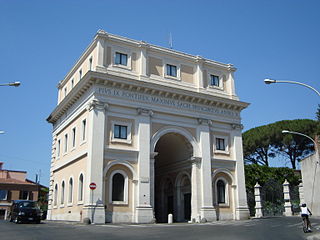
Porta San Pancrazio is one of the southern gates of the Aurelian walls in Rome, Italy.

Porta Nuova is one of the main business districts of Milan, Italy in terms of economy, and part of the Zone 2 administrative division. Named after the well-preserved Neoclassic gate built in 1810 on this site, it is now one of Italy's most high-tech and international districts, containing the country's tallest skyscraper: the Unicredit Tower.
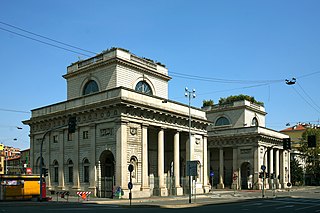
Porta Venezia is one of the historical gates of the city of Milan, Italy. In its present form, the gate dates back to the 19th century; nevertheless, its origins can be traced back to the Medieval and even the Roman walls of the city.
Porta Monforte is a district ("quartiere") of Milan, Italy, located within the Zone 3 administrative division. It is named after the eponymous city gate, which was added in the 1890s to the existing Spanish walls of the city. The gate was meant to serve as a customs office; the tax booths were designed by Luigi Tormenti and completed in 1889. While the addition of the Monforte city gate was intended to absorb part of the traffic going through Porta Venezia and Porta Vittoria, Porta Monforte remained a minor gate. The gate itself has since been demolished; it was located in what is now Piazza del Tricolore.

Porta Vittoria was a city gate in the Spanish walls of Milan, Italy. While the walls and the gate have been demolished, the name "Porta Vittoria" has remained to refer to the district ("quartiere") where the gate used to be. This district is part of the Zone 4 administrative division of Milan.

Porta Romana is a former city gate of Milan, Italy. In its present form, the gate dates back to the 16th century Spanish walls of Milan; its origins can be traced further back to the Roman walls of the city, which had a corresponding "Roman Gate" roughly in the same area. Porta Romana was the first and the main imperial entrance of the entire city of Milan, as it was the starting point of the road leading to Ancient Rome.
Porta Vigentina was one of the city gates in the Spanish walls of Milan, Italy; the gate has since been demolished, but the phrase "Porta Vigentina" is still used to refer to the district ("quartiere") where the gate used to be. The area is part of the Zone 5 administrative division of Milan.
Porta Lodovica was a city gate of the Spanish walls of Milan, Italy, named after Ludovico Sforza. Today, the name refers to the district (quartiere) of Milan where the gate used to be, which is part of the Zone 5 administrative division. The gate was demolished at the end of the 19th century. Plans were made to rebuild it inside the Parco di Monza city park in Monza, but they were not implemented.
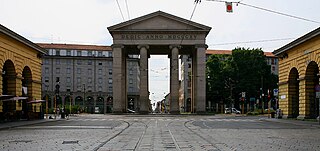
Porta Ticinese is a former city gate of Milan, Italy. The gate, facing south-west, was first created with the Spanish walls of the city, in the 16th century, but the original structure was later demolished and replaced in the early 19th century. The name "Porta Ticinese" is used both to refer to the gate proper and to the surrounding district, part of the Zone 6 administrative division. In the same district there is also a medieval gate with the same name, although in common speech the name "Porta Ticinese" is usually assumed to refer to the 19th century gate.

Porta Genova is a neighborhood ("quartiere") of Milan, Italy, located within the Zone 6 administrative division. The name "Porta Genova" means "Genoa gate"; the district is named after a city gate of the old Spanish Walls of Milan, namely that leading to Genoa, that used to be in what is now Piazza Cantore. The only remnants of the old gate are the small buildings that used to house the customs offices, which replaced the Spanish gate in the 19th Century.

Porta Magenta, formerly known as Porta Vercellina, was one of the city gates of Milan, Italy. The gate was established in the 9th century, with the Roman walls of the city; it was moved with the medieval and Spanish walls, and was finally demolished in the 19th century. The phrase "Porta Magenta" is now used to refer to the district ("quartiere") where the gate used to be; the district is part of the Zone 7 administrative division of Milan, west of the city centre.

Porta Volta is a former city gate of Milan, Italy, part of the Spanish walls. Nowadays, the name "Porta Volta" is most commonly used to refer to the surrounding district ("quartiere"), part of the Zone 8 administrative division of the city.

The Centro Direzionale di Milano is a business district (quartiere) in Milan, Italy, part of the Zone 9 administrative division. It is located north-west of the city centre, between the major railway stations of Milano Centrale and Milano Porta Garibaldi. The district developed in the second half of the 20th century; its realization was planned by the city administration to relieve congestion in the city centre by moving business and tertiary activities in the new area. Coherently with this plan, the district is mainly occupied by modern office buildings, including several of Milan's skyscrapers.
The city Milan, Italy, has had three different systems of defending walls. The oldest, Roman walls were developed in two stages, the first in the Republican and the second in the Imperial era. The second wall system was realized in the Middle Ages, after the destruction of the city by Frederick I Barbarossa. Finally, the latest wall system was built by the Spanish rulers. While very little remains of these walls, their structure is clearly reflected in the urbanistic layout of the city. In particular, modern Milan has two roughly circular rings of streets, namely the "Cerchia dei Navigli" and the "Cerchia dei Bastioni", which essentially correspond to the Medieval and Spanish walls, respectively. Note that a third ring of roads just beyond the Inner Ring Road, called the External Ring Road, does not owe itself to any old city walls; but was part of the 1884 Beruto Plan for the city of Milan, created and named after a municipal engineer and public servant to the local city government.
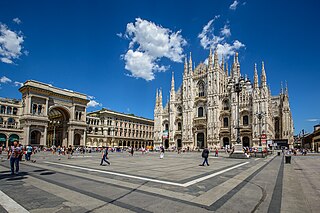
The Zone 1 of Milan, since 2016 officially Municipality 1 of Milan, is one of the 9 administrative divisions of Milan, Italy.

Viale Pasubio is an avenue in Milan, Italy. It is part of the circonvallazione interna ring road, a major traffic route that runs along the former Spanish walls of Milan. The street is 350 m long and connects two former city gates, namely Porta Garibaldi and Porta Volta. The street was formerly known as "Viale di Porta Garibaldi", and was renamed after World War I in remembrance of the fightings on the Pasubio massif (Dolomites) that occurred during the war.

The Porta Garibaldi, previously known as the Porta Comasina, is a city gate located in Milan, Italy, on the old road to Como. The Neoclassical arch was built to commemorate the visit of Francis I of Austria in 1825. It was reconstructed from 1826 to 1828 by Giacomo Moraglia and dedicated to Garibaldi in 1860. Built in the Doric style, the gate is flanked by two portals overlooking the street. The customs houses were added in 1836. Its less than monumental proportions are better suited to the surrounding streets as the gate used to be at the end of a winding road, hardly compatible with a grandiose project.

Porta Nuova is one of the two medieval gates of Milan that still exist in the modern city. It is sited along the ancient "Navigli Ring" on the perimeter of the medieval walls of the city.
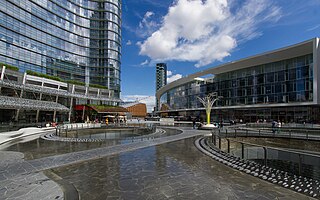
The Zone 9 of Milan, since 2016 officially Municipality 9 of Milan, is one of the 9 administrative divisions of Milan, Italy.
















